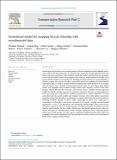Files in this item
Generalized model for mapping bicycle ridership with crowdsourced data
Item metadata
| dc.contributor.author | Nelson, Trisalyn | |
| dc.contributor.author | Roy, Avipsa | |
| dc.contributor.author | Ferster, Colin | |
| dc.contributor.author | Fischer, Jaimy | |
| dc.contributor.author | Brum-Bastos, Vanessa | |
| dc.contributor.author | Laberee, Karen | |
| dc.contributor.author | Yu, Hachen | |
| dc.contributor.author | Winters, Meghan | |
| dc.date.accessioned | 2021-03-01T09:30:06Z | |
| dc.date.available | 2021-03-01T09:30:06Z | |
| dc.date.issued | 2021-04 | |
| dc.identifier | 272336997 | |
| dc.identifier | 2c81c3c7-727e-4bae-94b8-3e7ba29cc622 | |
| dc.identifier | 85101619467 | |
| dc.identifier | 000636094000007 | |
| dc.identifier.citation | Nelson , T , Roy , A , Ferster , C , Fischer , J , Brum-Bastos , V , Laberee , K , Yu , H & Winters , M 2021 , ' Generalized model for mapping bicycle ridership with crowdsourced data ' , Transportation Research Part C: Emerging technologies , vol. 125 , 102981 . https://doi.org/10.1016/j.trc.2021.102981 | en |
| dc.identifier.issn | 0968-090X | |
| dc.identifier.other | ORCID: /0000-0002-5865-0204/work/90112358 | |
| dc.identifier.uri | https://hdl.handle.net/10023/21529 | |
| dc.description | This work was supported by a grant (#1516-HQ-000064) from the Public Health Agency of Canada. MW is supported by a Scholar Award from the Michael Smith Foundation for Health Research. | en |
| dc.description.abstract | Fitness apps, such as Strava, are a growing source of data for mapping bicycling ridership, due to large samples and high resolution. To overcome bias introduced by data generated from only fitness app users, researchers build statistical models that predict total bicycling by integrating Strava data with official counts and geographic data. However, studies conducted on single cities provide limited insight on best practices for modeling bicycling with Strava as generalizability is difficult to assess. Our goal is to develop a generalized approach to modeling bicycling ridership using Strava data which enables detailed mapping that is more inclusive of all bicyclists and will support better and more equitable decision-making across cities. We used Strava data, official counts, and geographic data to model Average Annual Daily Bicycling (AADB) in five cities: Boulder, Ottawa, Phoenix, San Francisco, and Victoria. Using a machine learning approach, LASSO, we identify variables important for predicting ridership in all cities, and independently in each city. Using the LASSO-selected variables as predictors in Poisson regression, we built generalized and city-specific models and compared accuracy. Our results indicate generalized prediction of bicycling ridership on a road segment in concert with Strava data should include the following variables: number of Strava riders, percentage of Strava trips categorized as commuting, bicycling safety, and income. Inclusion of city-specific variables increased model performance, as the R2 for generalized and city-specific models ranged from 0.08–0.80 and 0.68–0.92, respectively. However, model accuracy was influenced most by the official count data used for model training. For best results, official count data should capture diverse street conditions, including low ridership areas. Counts collected continuously over a long time period, rather than at peak periods, may also improve modeling. Modeling bicycling from Strava and geographic data enablesmapping of bicycling ridership that is more inclusive of all bicyclists and better able to support decision-making. | |
| dc.format.extent | 15 | |
| dc.format.extent | 4995212 | |
| dc.language.iso | eng | |
| dc.relation.ispartof | Transportation Research Part C: Emerging technologies | en |
| dc.subject | Bias-correction | en |
| dc.subject | Exposure | en |
| dc.subject | Big data | en |
| dc.subject | LASSO | en |
| dc.subject | Bicycling ridership | en |
| dc.subject | Strava | en |
| dc.subject | G Geography (General) | en |
| dc.subject | 3rd-DAS | en |
| dc.subject.lcc | G1 | en |
| dc.title | Generalized model for mapping bicycle ridership with crowdsourced data | en |
| dc.type | Journal article | en |
| dc.contributor.institution | University of St Andrews. School of Geography & Sustainable Development | en |
| dc.identifier.doi | 10.1016/j.trc.2021.102981 | |
| dc.description.status | Peer reviewed | en |
| dc.date.embargoedUntil | 2021-02-27 | |
| dc.identifier.url | https://www.sciencedirect.com/science/article/pii/S0968090X21000176?via%3Dihub#s0090 | en |
This item appears in the following Collection(s)
Items in the St Andrews Research Repository are protected by copyright, with all rights reserved, unless otherwise indicated.

